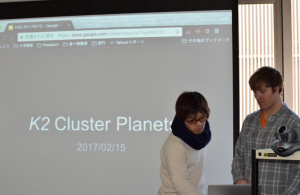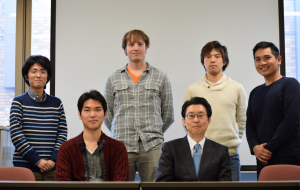Introduction to research group: Motohide Tamura
Members
- Motohide Tamura (Prof.)
- Norio Narita (Asst. Prof.)
- John Livingston (D2)
- Taichi Uyama (D2)
- Ishizuka (D1)
- Yusuke Tanaka (M2)
- Jerome de Leon (M1)
- Yuka Terada (M1)
- Mayuko Mori (B4)
Members and their positions are as of 2017 June.
Summary of our research fields from a general point of view
Direct imaging of exoplanets and their formation sites with Subaru Since the first detection around normal stars in 1995, more than 500 exoplanets have been detected. Furthermore 1000 or more candidates have been recently reported by the Kepler mission. Direct imaging can explore the wide-orbits planets around young stars that are difficult to observe with other methods. Due to the huge contrast between the central star and planet, direct imaging of exoplanets is technically challenging but is finally becoming successful on 8-m class telescopes. Strategic Explorations of Exoplanets and Disks with Subaru (SEEDS) is the first Subaru Strategic Program, whose aim is to conduct a direct imaging survey for giant planets as well as protoplanetary/debris disks at a few to a few tens of AU region around 500 nearby solar-type or more massive young stars devoting 120 Subaru nights for 5 years. We present its early results including detection of planet candidates and discovery of unprecedented details of several protoplanetary disks.
Research Interest and Experience
- Exoplanets, brown dwarfs, star and planet formation, astronomical polarimetry, infrared instrumentation
- P.I. of IRD (Infrared Doppler) instrument
- P.I. of the SEEDS (Strategic Explorations of Exoplanets and Disks with Subaru) project
- P.I. of CIAO (Coronagraphic Imager with Adaptive Optics) for the Subaru Telescope
- P.I. of SIRIUS (Simultaneous-color InfraRed Imager for Unbiased Surveys) for the IRSF telescope
- P.I. of HiCIAO (High Contrast Instrument for the next generation Adaptive Optics) for Subaru
See also a personal webpage of MT (japanese): http://esppro.mtk.nao.ac.jp/~hide/
Summary of research topics of each member
John Livingston (PhD student)
My research is focused on detecting and characterizing planets via the transit method, which is the most successful planet discovery method to date. By analyzing the transit light curve of a planet host star, we can gain amazingly detailed insights into the physical and orbital properties of the planet, in spite of not being able to “see” the planet directly. Because the transit method provides information which is relative to the properties of the host star, we must also use spectroscopy and other methods to estimate the host star’s physical properties. One consequence of the relative nature of transit light curves is that we can detect smaller planets orbiting smaller stars, since for a constant planet size, the amplitude of the signal increases with decreasing stellar radius. Thus, if we want to discover and study planets similar to Earth, one of the most promising avenues for doing so is to study late-type stars, whose radii are smaller than solar-type stars. It just so happens that nature has been kind to us and produces small planets very frequently around such small stars.
One noteworthy recent example of this is the TRAPPIST-1 system, which is a very small star now known to host seven transiting Earth-size planets. Because this star is small and relatively close to us, it will provide many exciting opportunities to study its planets in greater detail in the future. This system is also an example of when transits reveal not only planet sizes, but also their masses. We can use observed deviations in the timing of the planets’ transits to constrain their masses (and eccentricities) by modeling the dynamical interactions between the different planets in the system, known as the transit timing variation (TTV) method.
Special orbital architectures are required to produce TTVs, so for most planetary systems we can only measure planet masses by monitoring the reflex motion of the star induced by the gravitational pull of the planet, known as the radial velocity (RV) method. However, small stars like TRAPPIST-1 are very faint at optical wavelengths, where today’s best radial velocity spectrographs operate (e.g. HARPS, HIRES, HDS). This makes new infrared instruments such as IRD especially exciting, as they will be more sensitive to the light emitted by these small stars (Tamura et al. 2012, Proc. SPIE 8446, doi:10.1117/12.925885). By measuring the masses of small transiting planets, we can learn about their bulk densities and compositions, which will help us assess their habitability, as well as shed light on theories of planet formation and migration.
鵜山太智 / Taichi Uyama
直接撮像法を用いた非常に若い系外惑星系の探査
1995年に初めて太陽とは別の恒星を回る惑星(系外惑星)が発見され、現在までに数千もの系外惑星が報告されている。驚くべきことに、これらの系外惑星は太陽系と全く異質なものが多い。ここで疑問となるのは、太陽系と他の星で見つかった惑星はどうして差が生まれたのだろうか?という点である。科学者のみならず、人類の夢となっている「第二の地球」や「地球外生命体」を見つける為にも、まずどうやってこれらの惑星が誕生して成長したのかを知りたくなる。
さて、それではどうやって惑星を検出するかというと、僕は「直接」画像として惑星を発見しようとしている。百聞は一見に如かずと言う様に、明らかに惑星を見つけられる点で大きなインパクトを与える。宇宙に点在する恒星と比べて惑星は非常に小さく暗いものだが、すばる望遠鏡(@ハワイ)のような世界的な大型望遠鏡を用いて着々と検出数を増やしている。この方法を使って、惑星が生まれる瞬間を捉えようとしている。
Direct Imaging Search for Exoplanet around Young Stellar Object
Since the first convincing detection of an extrasolar planet (exoplanet) around a main sequence star in 1995, thousands of exoplanets have been confirmed. Surprisingly, many exoplanets are quite different from those in the solar system. Here one question; what diversifies planets in the Solar system and in other “Solar” systems? In order to detect our dream, not only scientists but also general people, of “an Earth 2.0” or “extraterrestrial life”, systematic planet formation and evolution mechanism should be defined.
By the Way, how do we detect exoplanets – I use “direct imaging” method. Literally I try to directly detect exoplanets around stars. Compared to stars, planets are much smaller and fainter, however, world-class large aperture telescopes such as Subaru (@Hawaii) enable us to detect exoplanets. I usually use this method aiming at very young exoplanet, namely ongoing planet formation.
石塚将斗 / Masato Ishizuka
For my master’s thesis, I worked on scrambling technique to improve the performance of Infrared Doppler instrument to be commissioned on Subaru telescope in late 2017. For my PhD, I wish to use IRD for RV observations of nearby exoplanets around late-type host star.
田中祐輔 / Yusuke Tanaka
以前は「重力マイクロレンズ法」という系外惑星の探査方法を用い、銀河系中心方向の星、褐色矮星、惑星の質量の分布を調べる研究を行なっていた。今後はすばる望遠鏡のHSC(Hyper Supreme Cam)という装置を用いて星形成領域における低質量天体(褐色矮星・浮遊惑星)の分布を調べる予定である。
I previously worked on statistical approach with microlensing method.
Recently I am working on imaging of low-mass object such as free floating planets or brown dwarfs with Subaru telescope’s instrument called HSC. I am planning to reveal how many such objects exist in a star forming region.
Jerome de Leon
I previously worked on direct imaging of circumstellar disk the young stellar object (YSO) named SU Aurigae (SU Aur) using the Subaru telescope. I am planning to conduct polarimetric observation using Subaru’s infrared camera instrument called IRCS of YSO with disks previously observed by K2 for the first time. Aside from direct imaging, I am also interested in transiting exoplanets and studying their atmosphere using the new MuSCAT2 instrument. In the future, I am hoping to work with Subaru telescope’s new integral field unit (IFU) instrument called CHARIS for direct imaging+spectroscopic characterization of young nearby exoplanets.
Yuka Terada
I am interested in research on astrobiology. I previously studied astrobiology research using the next generation radio telescope, especially magnetospheric radio emissions from exoplanets. From now on, I would like to learn the atmospheric observation of extraterrestrial planet by transit spectroscopy observation and various other observation methods and to continue my research.
森万由子 / Mayuko Mori
私の興味は、地球外生命を探すことを究極の目的とする「アストロバイオロジー」という研究分野にある。そのための天文学的なアプローチとして、トランジット法をはじめとする様々な方法を組み合わせ、候補となる系外惑星を詳細に調べ、生命が居住できる「ハビタブル惑星」かどうかを確かめるという方法がある。例えば、惑星の密度や軌道、温度変化を調べたり、惑星大気を通過してきた光をスペクトルに分け、大気に含まれる成分を調べたりすることで、地球外生命の手がかりを探している。
My research interest is especially in “Astrobiology,” which is the study of searching for extraterrestrial life. We combine many ways to detect exoplanets, including transit method,in order to examine whether or not each exoplanet is habitable. For example, we compare the density, orbit and temperature gradient of exoplanets, and detect chemical species in the exoplanet atmosphere using transmission spectroscopy.
Pictures of activities
Every wednesday, one member of the group has to present his own work or recent papers relevant to our research group.

From left to right: K. Sato, N. Narita, J. Livingston, M. Tamura, T. Uyama, J. de Leon; not in picture: Y. Tanaka and M. Ishizuka






